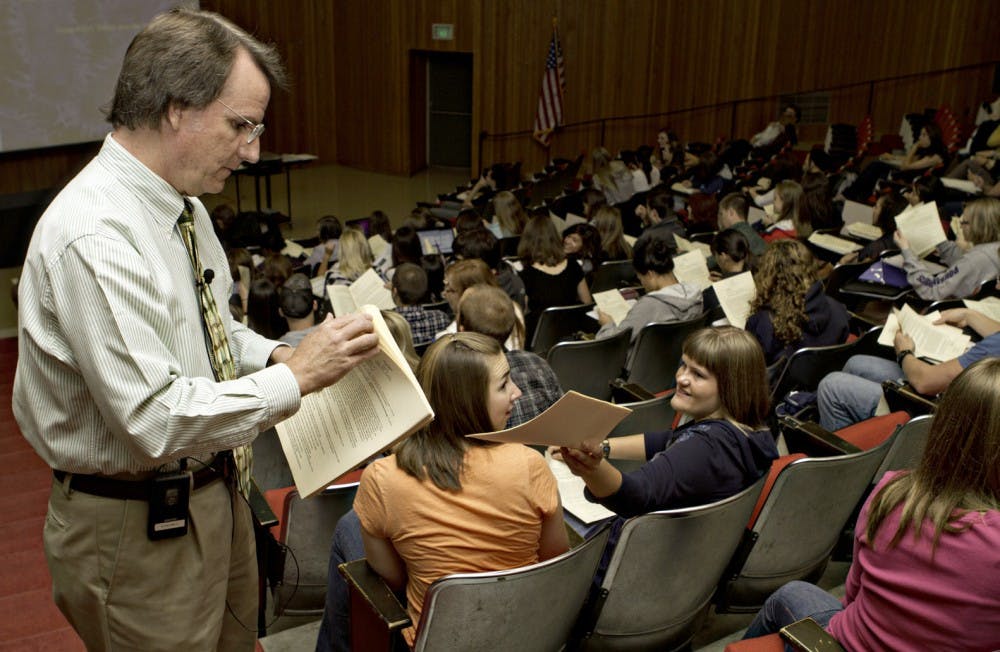Biology professor David Alexander passes out syllabi to his microbiology class of 103 students. The biology department has had to add to adjust to the larger freshmen class by adding new sections and hiring new faculty. (Bryan Brenize -- The Beacon)
By Elizabeth Vogel, Staff Writer -- vogel11@up.edu
Victoria Johnson, a freshman nursing major, waits in the halls of Shiley for her first biology class. She is anxious.
"I'm concerned that the teacher won't get to know us as well. That we won't get enough help," she said.
Johnson's concern is not unfounded. With the increasing number of new freshmen each year, many departments have had to adjust. More sections were added for intro classes and several classes are over capacity.
Nine hundred new faces on The Bluff have already caused a ripple effect in the academic realm. Some departments, like biology, had to change in order to accommodate everyone. After adding new sections, hiring new faculty and taking on some extra work, the biology department is prepared for its huge influx of students.
Professor Katie O'Reilly is the chair of the biology department, and she is ready for the semester.
"It'll be fun having them around," she said about the new students.
The biology department is at capacity and had to turn away some students looking to take intro biology courses. Each section of Foundations of Biology, Organismal and Population Biology and Introductory Cell Biology and Genetics hovers around 60 students.
"That's difficult for both professors and students," O'Reilly said.
To accommodate all the students, the department hired a new faculty member to help out with the labs.
"If we didn't have such a jumbo class, we wouldn't have had to hire," O'Reilly said.
Because there is a limit to the number of students that can be in a lab room, it was necessary to add more lab times instead of putting more students into existing labs, according to O'Reilly.
The faculty in the biology department is stretched. The professors have more students in their classes and more advisees. Tenured professors each advise about 40 students, and lecturers have about 20 advisees. It is unusual for lecturers to take on any advisees at all, according to O'Reilly.
The biology faculty is not shying from the extra workload.
"I was amazed, [the professors] offered to take more," O'Reilly said.
Freshman nursing major Colleen Cooper was surprised to learn that her Foundations of Biology class has 63 students.
"I thought because the school was smaller than state schools the classes would have around 30 people," Cooper said.
The department created more student-led workshops to give students time for smaller group studying and hired more teacheringassistants to help out the professors, according to O'Reilly.
Some other smaller changes were made to accommodate larger numbers of students. Students can take either Organismal and Population Biology or Introductory Cell Biology and Genetics first. Last semester Organismal and Population Biology was a requirement for Introductory Cell Biology and Genetics. This change will help spread the students out.
McDonald said that more sections were added to many departments in order to keep class sizes smaller. The student to faculty ratio is 13:1 at the University of Portland, according to McDonald. In individual departments, like biology, this ratio may be different.
Despite the stress the increase in students will have on the biology department, Professor O'Reilly is excited to have them around.
The biggest challenge she foresees?
"It's a lot of names to learn."
The percentage of freshmen pursuing engineering, education, business, nursing or CAS degrees.








